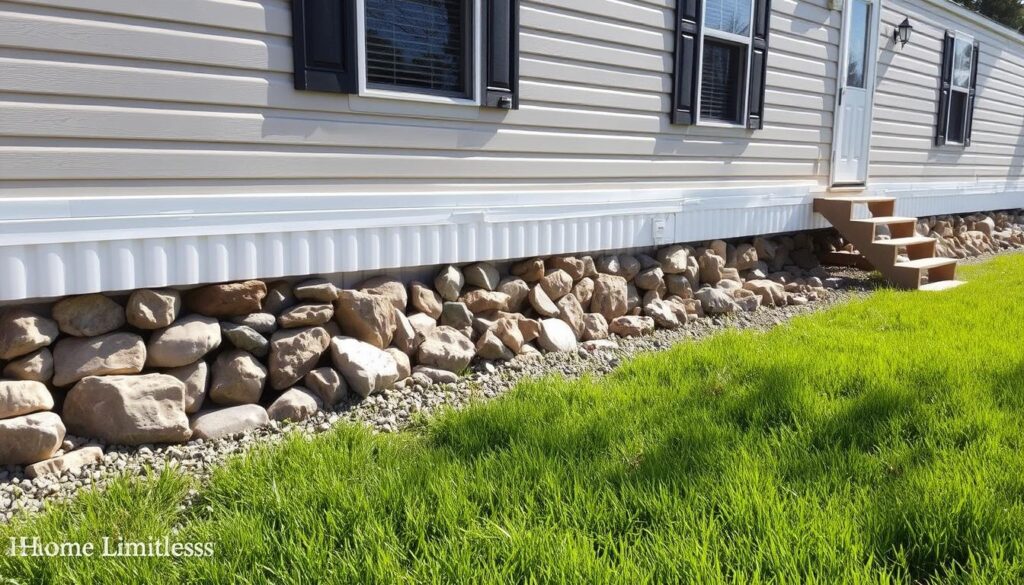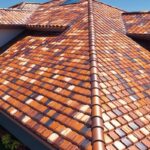Rock skirting is a great mix of looks and usefulness. It’s made to look like real stone but is actually polyurethane. The installation of mobile home skirting can really boost your home’s value. It also keeps pests and weather out.
With the right setup and care, rock skirting can last a long time. It keeps your home’s underside safe and helps keep it cool inside. Let’s explore how rock skirting can make your mobile home look and feel better.
Table of Contents
Key Takeaways
- Rock skirting enhances both aesthetic appeal and protection for mobile homes
- Proper installation can increase a manufactured home’s resale value
- Skirting materials come in various options, including faux brick and stone
- Adequate ventilation is crucial to prevent moisture buildup
- Regular maintenance extends the lifespan of rock skirting
- Installation requires specific tools and measurements for best results
- Rock skirting often meets or exceeds local building codes
Understanding Mobile Home Skirting
Mobile home skirting is key to protecting and improving your home. It acts as a protective barrier, also known as mobile home underpinning. It serves many purposes beyond just looking good.
What is mobile home skirting?
Mobile home skirting is a material that covers the area between the ground and your home’s bottom. It’s available in vinyl, metal, and rock. Vinyl is popular because it’s affordable and easy to put up. It comes in 11’8″ panels, making it simple to adjust for uneven ground.
Importance of skirting for mobile homes
Skirting protects against pests, weather, and moisture. It keeps plumbing and structures safe, helps keep temperatures inside steady, and can even lower insurance costs. It also makes your mobile home look better.
Benefits of rock skirting
Rock skirting has many advantages over other materials:
- It’s very durable and weather-resistant.
- It gives a high-end look like natural stone.
- It insulates better.
- It lasts longer than vinyl.
For instance, Reil Rock skirting is available in 60″ sections. It comes in heights of 32″, 36″, or 48″. Made from ABS, it can handle tough weather.
| Skirting Type | Durability | Cost | Appearance |
|---|---|---|---|
| Vinyl | Low | Low | Basic |
| Metal | High | Medium | Industrial |
| Rock | Very High | High | Premium |
Types of Rock Skirting Options
Rock skirting is a great way to make your mobile home look better. Let’s look at the main types you can choose from.
Faux Rock Panels
Faux rock skirting is a favorite for mobile homes. It’s made from strong materials like polyurethane, looking like real stone. You can pick from many textures and colors to fit your home’s look.
These panels are light, making them easy to install and cheaper to ship.
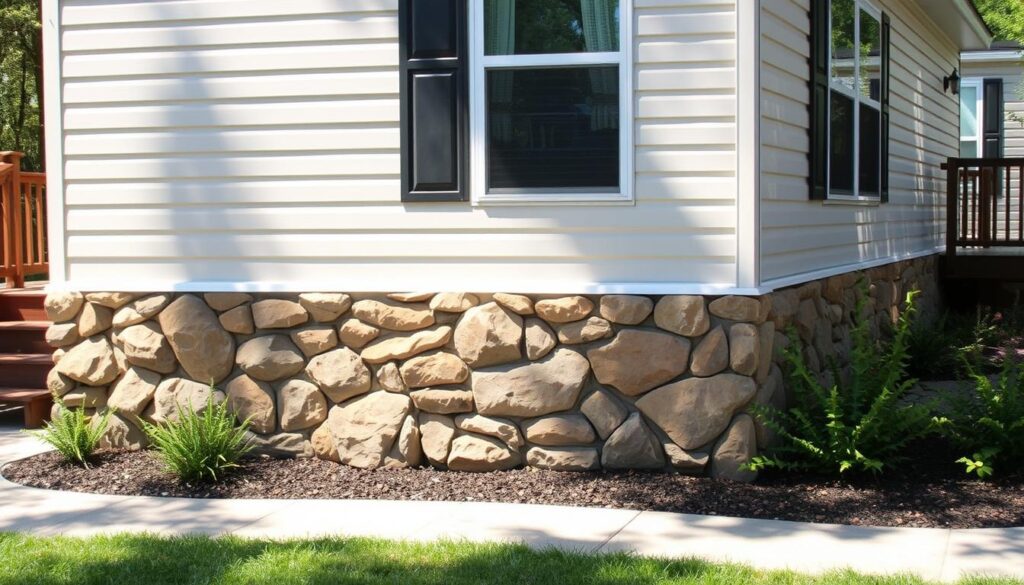
Natural Stone Veneer
Stone veneer gives your mobile home a real stone look. It’s more expensive than faux options but offers a premium look. Natural stone is tough and can handle the weather, lasting a long time.
Simulated Stone Skirting
Simulated stone panels are a mix of durability and realistic stone appearance. They’re made from strong plastic and are a bit pricier than vinyl but cheaper than natural stone. You can find them in styles like river rock, stacked stone, and cobblestone.
| Skirting Type | Material | Cost | Durability | Installation |
|---|---|---|---|---|
| Faux Rock Panels | Polyurethane | Moderate | High | Easy |
| Natural Stone Veneer | Real Stone | High | Very High | Difficult |
| Simulated Stone Panels | Sturdy Plastic | Moderate-High | High | Moderate |
When picking rock skirting, think about your budget, the look you want, and how easy it is to install. Each type has its own benefits, helping you make your mobile home’s exterior beautiful and safe.
Preparing for Mobile Home Rock Skirting Installation
Before starting rock skirting on your mobile home, site preparation is key. This involves several important steps for a smooth installation.
First, clear the area around your mobile home. Remove debris, plants, or obstacles that could get in the way. This step is crucial for a clean workspace.

Then, level the ground. Use a level to find uneven spots around your home’s foundation. You might need to grade or backfill areas for a uniform surface. This makes sure your rock skirting looks even and professional.
Check for existing fixtures, pipes, or wires that could impact the installation. Mark their spots clearly to avoid damage. Also, check local building codes to make sure your installation meets all requirements.
Finally, measure your home’s perimeter accurately. This helps figure out how much rock skirting material you’ll need. Add extra for cuts and corners.
“Proper site preparation is the foundation of a successful rock skirting installation. Take your time with this step to ensure the best results.”
By preparing your site well, you’re ready for a smooth installation. This leads to a beautiful, lasting rock skirting for your mobile home.
Tools and Materials Needed for Installation
Installing rock skirting on your mobile home needs careful planning. Let’s look at the tools, materials, and safety gear you’ll need for this project.
Essential Tools
To make the installation smooth, get these key tools:
- Hammer
- Box level
- Measuring tape
- Circular saw
- Tin snips
- Chalk line
- Snap lock punch tool
Required Materials
You’ll need these skirting materials:
- Faux rock or stone panels
- Strapping strips
- Starter strips
- Corner bases
- Trim pieces
- Nails or screws
- Copolymer adhesive (for faux panels)
Buy about 10% extra material for any mistakes or damage.
Safety Equipment
Don’t forget your safety gear:
- Work gloves
- Safety glasses
- Dust mask
- Sturdy work boots
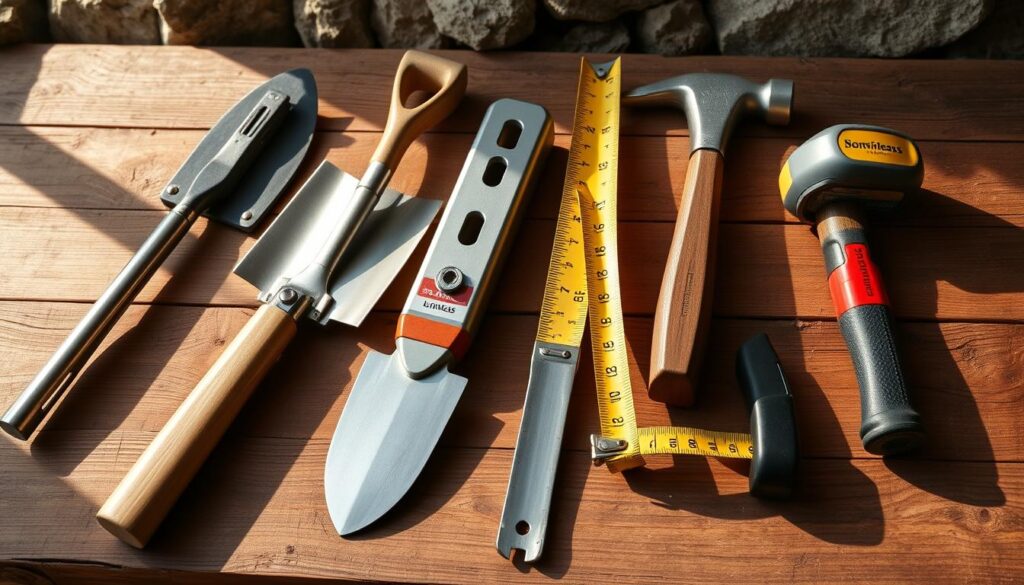
| Category | Items | Purpose |
|---|---|---|
| Tools | Hammer, saw, level | Cutting and installing panels |
| Materials | Panels, strips, adhesive | Building the skirting structure |
| Safety | Gloves, glasses, mask | Personal protection during work |
With these tools, materials, and safety gear, you’re ready to start your rock skirting project.
Step-by-Step Guide to Installing Rock Skirting
Installing rock skirting is a DIY project that can change your mobile home’s look. This guide will show you the key steps for a great installation.
First, prepare the support structure. Put up horizontal and vertical strapping strips for a strong base. Then, build a framework with gaps for access and ventilation. This is important for airflow and easy upkeep.
Next, attach the panels. Start with a starter strip at the bottom of your home. This gives a level base for the rock panels. Proper anchoring is key for stability, especially in windy weather.
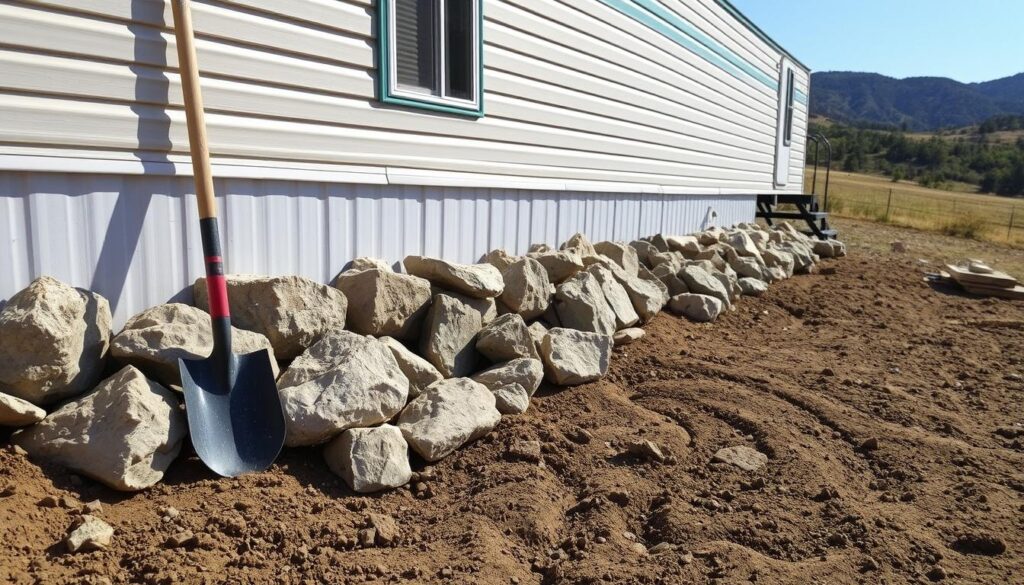
Attach the first panel, starting from left to right. Use 1-inch hex head screws every 12 inches to hold the panels. For heights over 36 inches, add a backing or frame to stop blowouts. Keep adding panels, allowing for expansion.
For a nice finish, install decorative corners if needed. Make sure to keep everything aligned. Keep the skirting at least 2 inches above the bottom trim to avoid moisture problems.
- Use a plumb line or level to ensure straight installation
- Cut panels with a power saw for custom fits
- Apply sealant at joints for added protection
By following these steps, you’ll get a professional-looking rock skirting installation. It will improve your mobile home’s look and protection.
Ventilation Considerations for Rock Skirting
Rock skirting adds elegance to mobile homes. But, it’s important to have good ventilation. This prevents moisture buildup and protects your home’s structure. Let’s look at the key aspects of ventilation for rock skirting.
Importance of Proper Ventilation
Good ventilation in your mobile home’s skirting is crucial. It controls moisture, prevents mold, and removes harmful gases. Without it, you risk damage to your home and health problems.
Effective ventilation can also save energy. It reduces the load on your heating and cooling systems.
Types of Vents for Rock Skirting
There are several vent options for rock skirting:
- Foundation vents: Installed around the perimeter for free airflow
- Hidden vent systems: Provide continuous ventilation without visible openings
- Traditional vents: Standard options that blend with rock skirting
Placement of Vents
Proper vent placement is key for good air circulation. Aim for at least one vent per 150 square feet of crawl space. Place vents on opposite sides for cross-ventilation.
This setup improves airflow and moisture control under your mobile home.
“The Hidden Vent System offers continuous venting with no dead air, making it an excellent choice for rock skirting.”
Remember to check and clean vents every year. Use a leaf blower to remove debris and keep airflow free. With the right ventilation, your rock skirting will look great and protect your mobile home for years.
Maintenance and Care for Rock Skirting
Keeping your mobile home’s rock skirting in top shape is key. Regular care helps it last longer and saves you money on repairs. Let’s look at some cleaning tips and ways to avoid damage.
To clean rock skirting, mix mild detergent with water. Don’t use harsh chemicals or pressure wash, as they can harm the surface. Use a soft brush to gently scrub off dirt and grime. Then, rinse well with clean water and let it dry.
Check your skirting often, especially after bad weather. Look for any loose panels, cracks, or wear. Fixing these issues quickly can stop more damage. Also, keep plants away from the skirting to avoid moisture buildup.
For faux rock or stone panels, check the attachments often. Tighten any loose screws or brackets. If you see fading or discoloration, apply a UV-resistant sealant to protect the finish.
“Proper maintenance of rock skirting can significantly extend its lifespan and enhance your mobile home’s appearance.”
Don’t forget to check your skirting’s ventilation. You should have 1 square foot of venting for every 150 square feet of space. This keeps air flowing and prevents moisture problems. While you’re at it, inspect other parts of your mobile home, like the gutters and downspouts.
| Maintenance Task | Frequency | Tools Needed |
|---|---|---|
| Cleaning | Every 3-6 months | Mild detergent, soft brush, water |
| Inspection | Twice a year | Flashlight, screwdriver |
| Vegetation trimming | As needed | Pruning shears, lawn mower |
| Sealant application | Every 2-3 years | UV-resistant sealant, brush |
Cost Considerations for Mobile Home Rock Skirting
Planning to add rock skirting to your mobile home? It’s key to know what affects the cost. The price changes based on the material, home size, and how hard it is to install. Let’s look at these factors and compare them with other skirting choices.
Factors affecting cost
The cost of rock skirting for mobile homes can range from $500 to several thousand dollars. The material you choose greatly affects the price. Faux rock panels and simulated stone skirting are a good mix of cost and durability. Natural stone veneer, however, is pricier.
The size of your home and how high it is from the ground also play a part in the final cost.
Comparison with other skirting options
Rock skirting is generally priced in the middle. Vinyl skirting is the cheapest, costing between $400 to $1,300. Metal skirting, like tin and steel, is strong and affordable. Foam skirting, though pricier, can cut energy loss by up to 22%.
Long-term value and ROI
Rock skirting may cost more upfront than some options. But it offers long-term benefits. It boosts your home’s curb appeal, saves on energy, and needs less upkeep than vinyl or wood.
When looking at the investment, think about how it might raise your home’s value and save on upkeep costs. DURASKIRT™ concrete panel skirting, made since 2000, is a good choice when considering long-term costs and benefits.

